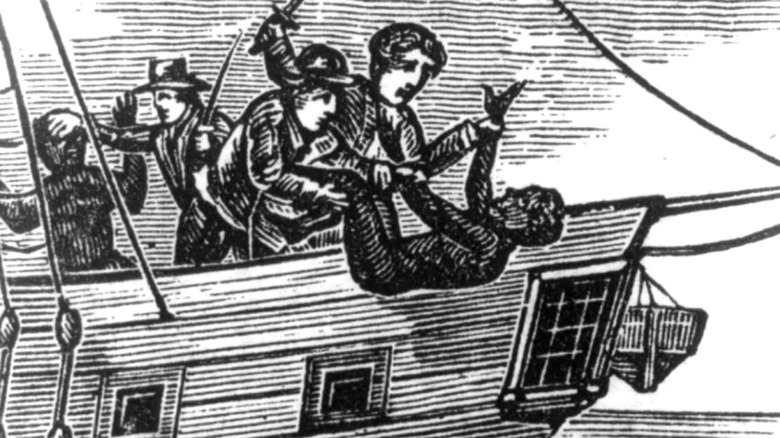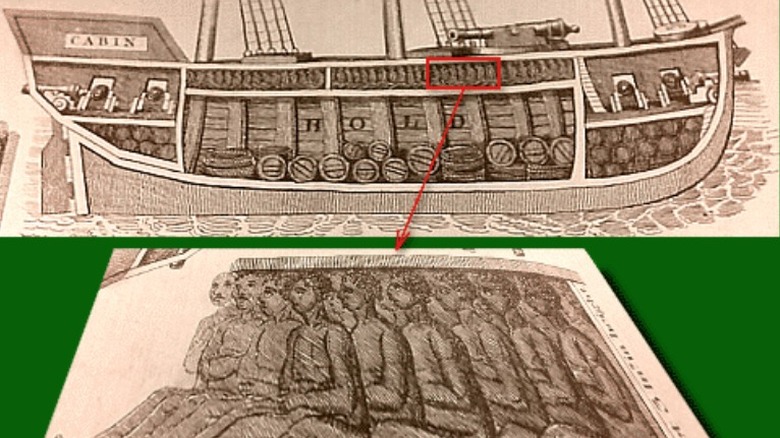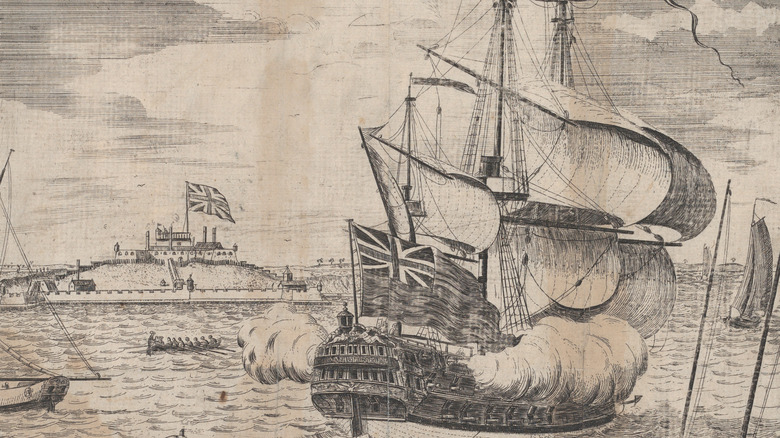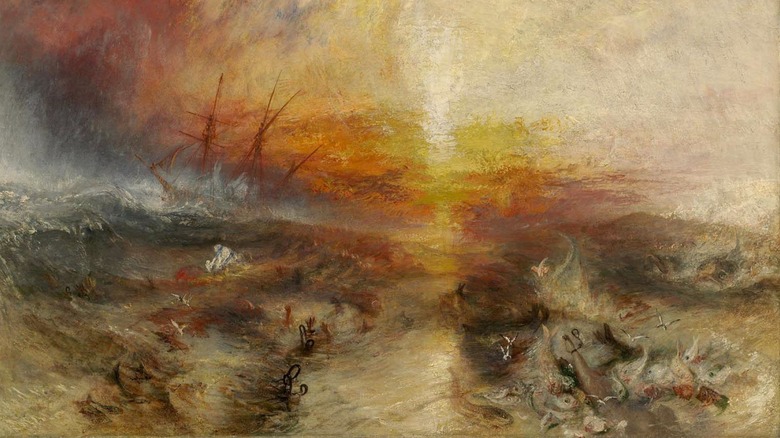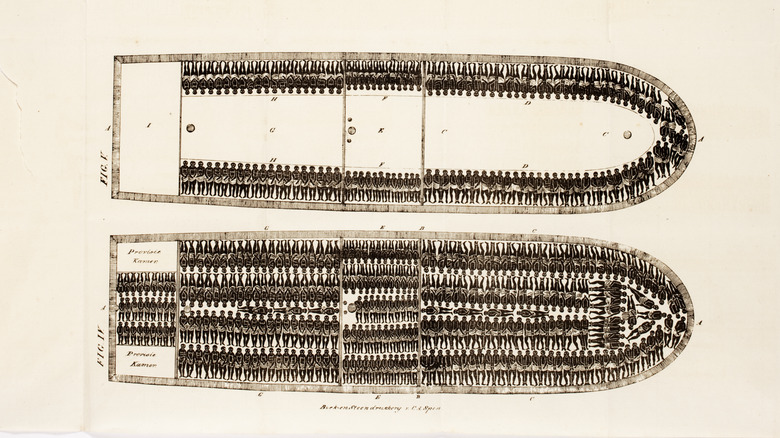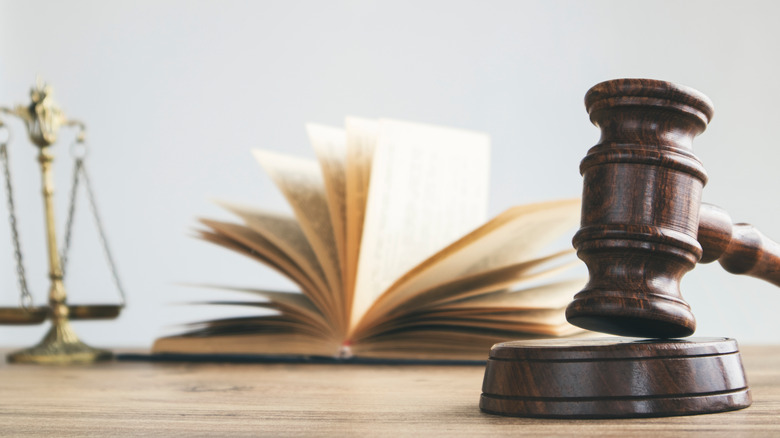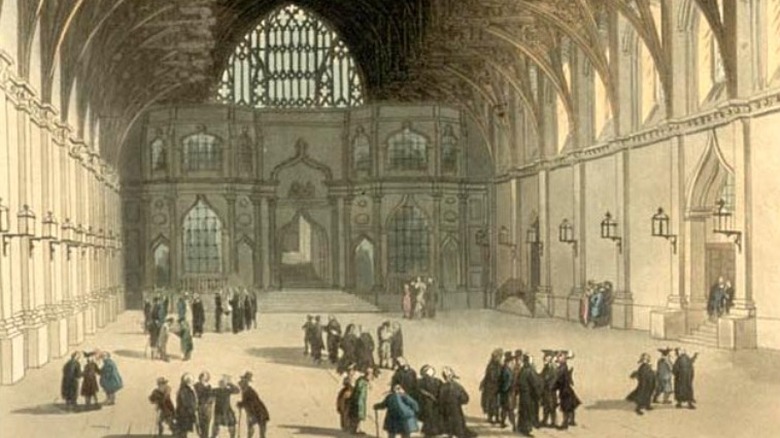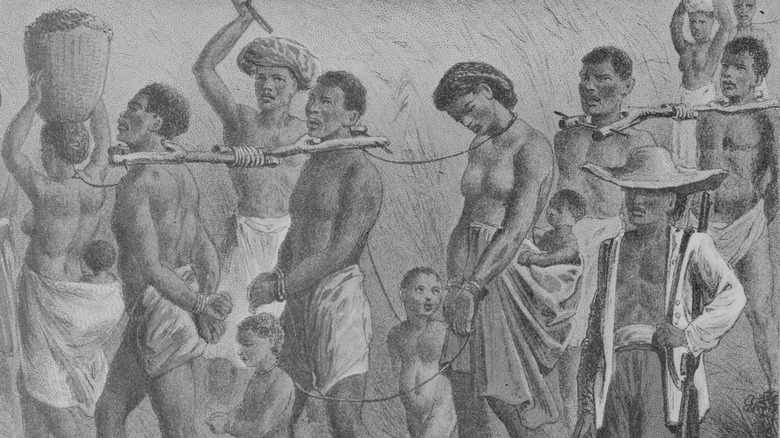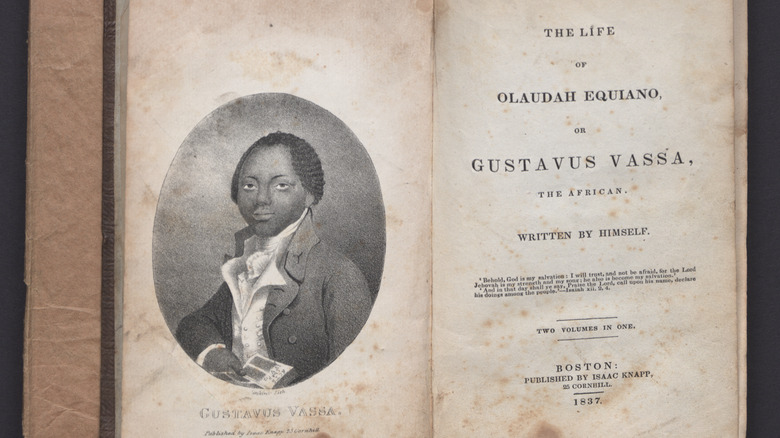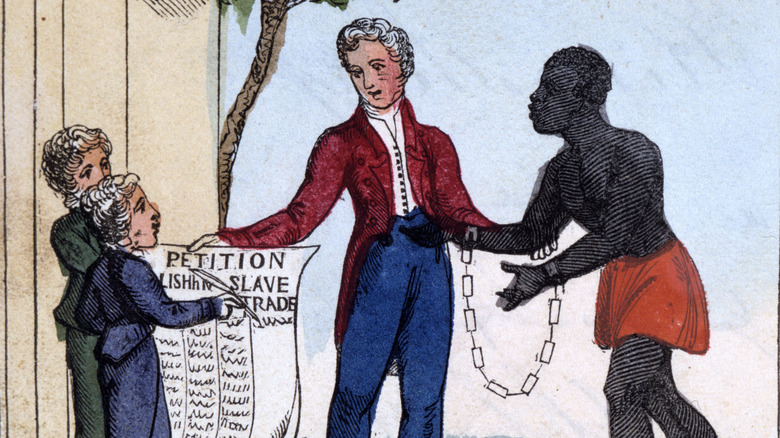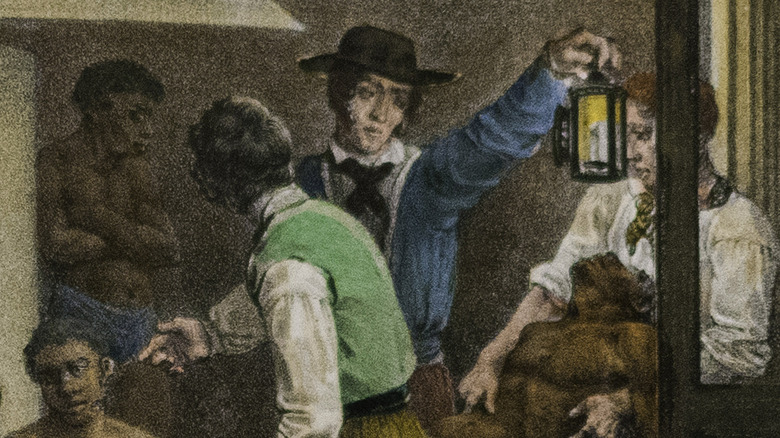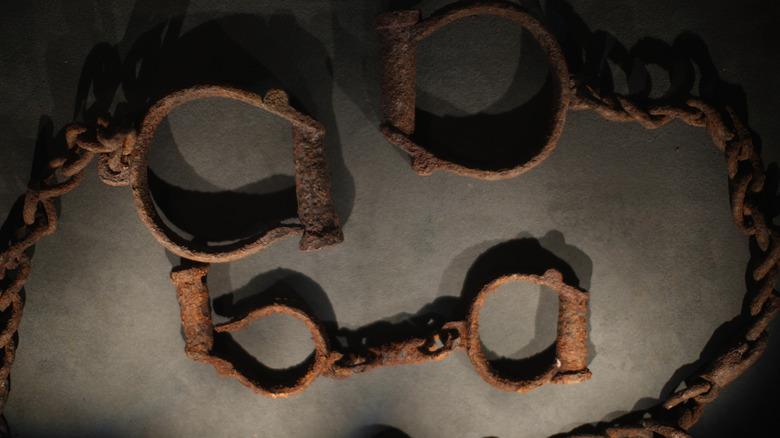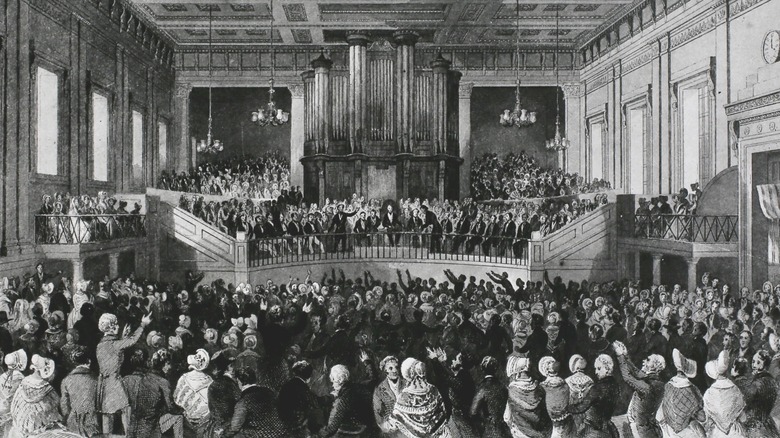The Messed Up History Of The Zong Massacre
In 1781, over 100 enslaved African people lost their lives after being thrown overboard a British enslaving ship. And once the ship returned to England, the ship's owners tried to get an insurance company to pay out for the profits that they'd lost as a result, making this possibly one of the first instances of insurance fraud by way of mass murder.
This incident brought the question of whether or not people were property, and whether or not profits should be prioritized over people, to the forefront of the British public. But unfortunately, this wasn't the first time that enslaved people would be murdered by being thrown overboard, and it wouldn't be the last.
However, although the massacre on the Zong wasn't the only massacre committed on an enslaving ship, the subsequent attention it garnered set the wheels in motion towards the abolition of enslavement in the British Empire. And although the process of ending enslavement dragged on for decades, and effectively continued in parts of the British Empire for over a century more, the Zong massacre was one of the first times that white people in England were made aware of the lengths that enslavers would go to just for a payday. This is the messed up history of the Zong massacre.
A brief history of the Zong
The Zong was a ship owned by the Middelburgsche Commercie Compagnie, based in Middleburg, Netherlands, that was used to transport enslaved people along the triangular trade during the 18th century. The ship has also been referred to as the Zorg or Zurg, and it's unclear if the slight variations in name are due to a misreading/misprinting or if the confusion was created deliberately by the ship's crew in order to "distance themselves from the murderous events that recently occurred upon it," Michelle Faubert writes in "Granville Sharp's Uncovered Letter and the Zong Massacre."
Face2Face Africa writes that although the Zong was initially owned by the Dutch, in 1777 it was seized by the British government and in 1781, it was sold to a syndicate of Liverpool merchants and traders of enslaved people at Cape Coast, Ghana. At the time when it was sold to the merchants, 244 enslaved African people had already been put aboard the ship and they were part of the transaction. And nobody knows how long they'd already been on board.
When the Zong left Ghana, there were 442 enslaved people on the ship and 19 crew members and one passenger. According to The Gleaner, insurance was also taken out on the ship, which "included £8,000 ($11,000) for the captives alone, at around £30 ($39) sterling per enslaved African." For its size, Zong should've had no more than 200 people on board.
The Zong's August 1781 voyage
On August 18, 1781, the Zong set sail from Ghana and after stopping at Sao Tome on September 6th to restock on water, the ship set sail towards Jamaica. According to Face2Face Africa, although the ship was due for another water restock around the third week of November, crew members decided not to stop the ship.
By November 28th, the ship reached Jamaica, but the crew members mistakenly believed that they'd instead reached Saint Domingue, Hispaniola, now known as the Dominican Republic and Haiti, and as a result continued their voyage. The ship sailed almost 300 nautical miles before they realized their mistake. By that time, the ship needed at least 10 days to get back to Jamaica, and there was only four days' worth of water left on the boat. And with little to no wind in the Doldrums, also known as the Intertropical Convergence Zone, the ship was essentially stranded.
Black Past writes that by November 29th, many of the enslaved people succumbed to malnutrition and disease. Up to 60 enslaved people had passed away as a result and seven crew members had also died, according to the Jamaica Observer. It was at this point that Luke Collingwood, captain of the Zong, decided that a massacre was the best course of action for the sake of his profits.
The Zong Massacre
The rationale behind the massacre was the fact that the insurance wouldn't cover the deaths of enslaved people due to disease or "natural causes." However, if enslaved people were thrown overboard in order to "save other ship members and property," then the insurance cover could be claimed. According to "A New Look at the Zong Case of 1783," at least 122 enslaved people were thrown overboard. Fifty-four people were murdered on November 29th, 42 were murdered on December 1st, and 26 were murdered on another day in early December. Other accounts put the number at 142, but even that may not cover the "maximum number of murder victims." The Gleaner writes that an additional 10 enslaved people died by suicide, throwing themselves overboard, which Collingwood would later describe as an "Act of Defiance."
AAREG writes that as people pleaded for their lives, one captive tried to compromise for the enslaved Africans to be "denied all food and drink rather than thrown into the sea." One person even managed to get back on board after being thrown off and tried desperately to convince the crew to stop the murders. But nobody listened. The crew claimed that they simply didn't have enough water for everyone.
By the time the Zong reached Jamaica on December 22, 1781, only 208 enslaved people remained out of the 442 that had started the voyage. And when the Zong arrived in Jamaica, it still had 420 gallons of water aboard.
What happened to the survivors?
Upon arriving in Jamaica, the survivors of the Zong massacre were sold to new enslavers. The Gleaner writes that at least 200 survivors were advertised for sale in a newspaper on January 9, 1782. The average cost of an enslaved person was $47. Unfortunately, there's little information about what happened to the surviving enslaved people after they were sold.
According to "Granville Sharp's Uncovered Letter and the Zong Massacre," there's reason to believe that the misdirection and unintended detour wasn't as unintended as the crew led others to believe. Since at least half of the enslaved people on the Zong had already been on the ship for an unknown amount of time, many likely weren't in the best state of health to begin with since conditions on the enslaving ships were some of the worst conditions a person could be in.
The Zong's crew was aware of this, and they likely realized that they weren't going to get a good price for anyone who didn't appear to be in the best of health. And since the enslaved people were "literally worth more dead than alive to the murders," it's likely that the ship was steered off course on purpose in order to justify the idea that they would have run out of water.
A trial over insurance
The Zong was renamed Richard of Jamaica and returned to England on October 26, 1782, where the ship's owner, James Gregson filed an insurance claim for the loss of the enslaved people who'd been murdered. According to A New Look at the Zong Case of 1783, Gregson claimed that the murdered enslaved people were lost due to "the perils of the sea," and sought a claim that compensated them on the basis of the average cost of the surviving enslaved people.
When the insurance company refused to pay, the Gregson syndicate sued and the resulting court case took place on March 6, 1783 in London. Although Thomas Gilbert, the insurance underwriter, disputed the claim and stated that the Zong had plenty of water when she arrived in Jamaica based on the inventory, the jury decided in favor of the ship's owners, The Gleaner writes. With this ruling, the murder of enslaved people was essentially deemed legal.
John Lee, the solicitor general, even claimed that the case wasn't even about murder, but concerned merely insurance and property. "What is this claim that human people have been thrown overboard? This is a case of chattels or goods. Blacks are goods and property; it is madness to accuse these well-serving honorable men of murder ... The case is the same as if wood had been thrown overboard," per Black Past.
Appealing the verdict
The verdict was appealed by the insurers, and they asked for another trial. However, as The Guardian notes, the insurers didn't appeal because they believed that murder had occurred. Instead, they appealed because they believed that the deaths "occurred as a result of errors of navigation and mismanagement of the vessel, namely insufficient water onboard."
On May 21 to 22, 1783, a hearing was held at the Court of King's Bench, where the insurers and the ship's owners once more made their arguments. But according to "A Chain of Murder in the Slave Trade," during this hearing it was discovered that "some of the murders had taken place after rain had restocked the ship with water," which meant that the ship owners' claim of lack of water was inaccurate.
The Earl of Mansfield, also known as Lord Mansfield, who was presiding over the hearing as he also had in the trial, ordered a retrial. However, there's no evidence that another trial ever took place.
Property over people
Although the Earl of Mansfield ordered a retrial, his comments during the hearing made it clear that the question was still about property rather than people.
"The matter left to the jury, was, whether it was from necessity; for they had no doubt (though it shocks one very much) that the case of slaves was the same as if horses had been thrown overboard ... if the slaves die a natural death, the underwriters do not pay for them, but, in an engagement, if they are attacked and the slaves are killed, they will be paid for as much as for damages done to goods," per BLACK and Education.
Although the lack of evidence for the retrial suggests that the ship's owners never got the money that they demanded from the insurers, nobody ended up being criminally charged either, according to Face2Face Africa. However, rather than fading away into the annals of history, the story of the Zong massacre was about to have a lasting impact on the trade of enslaved people in the British Empire.
Who were the Sons of Africa?
During the late 18th century, a group of African men who'd been freed from enslavement in Great Britain created an organization known as the Sons of Africa, which was concerned with ending the enslavement of African people. According to Face2Face Africa, their members included Olaudah Equiano and Ottobah Cugoano. And in addition to campaigning against enslavement, the group also spoke out against the colonization that would occur in Sierra Leone in the beginning of the 1800s.
According to Equiano's World, the Sons of Africa described themselves as "we, who are a part, or descendants of the much-wronged people of Africa" and worked on educating people about the horror that was enslavement. In 1789, Equiano published his autobiography, "The Interesting Narrative of the Life of Olaudah Equiano, Or Gustavus Vassa, The African," which revealed to many white Britains at the time what was going on during the process of enslavement.
Capturing Cambridge writes that the Sons of Africa was "Britain's first Black political organization." And they'd become incredibly influential in their campaign against enslavement, working alongside the Society for the Abolition of the Slave Trade, which was founded in 1787.
Raising awareness of the Zong Massacre
Olaudah Equiano was following the news of the Zong massacre and its subsequent trial, and after the murder of enslaved people was essentially deemed legal, he informed his friend, abolitionist Granville Sharp. According to AAREG, Sharp was the one who sought to have the ship's crew prosecuted for murder, but he was ultimately unsuccessful.
However, thanks to the media attention that the trial and the hearing already attracted, the Equiano and Sharp were able to raise an appropriate outcry over the murder. And in addition to underlining "the callous conduct of the crew," attention was also drawn to the fact that the British legal system treated mass murder as a mere issue of "maritime fraud." The Gleaner also notes that the efforts of Equiano and Sharp also introduced people like Reverend John Ramsay and William Wilberforce into the campaign against enslavement.
Their efforts had a direct effect on abolition in Britain. Understanding Slavery writes that "there is a direct line of descent from outrage at the Zong affair in 1783 to the founding of the Abolition Society in 1787."
Regulating the trade of enslaved people
Through the efforts of the Sons of Africa and the Society for the Abolition of the Slave Trade, Parliament passed the Slave Trade Act on July 10th, 1788, also known as The Dolben's Act of 1788. According to History Today, this was the first British legislation that regulated the slave trade.
The Slave Trade Act of 1788 mandated that enslaving ships could only transport "1.67 slaves per ton up to a maximum of 207 tons burthen, after which only 1 slave per ton could be carried," per AAREG. Another restriction was that no more than two-fifths of the enslaved people could be children. However, according to Children & Youth in History, this act ended up adversely affecting children and young people. Since the act didn't define what a child was, more children between the ages of 12 and 18 were enslaved. The act also led to a debate over whether or not forcing enslaved people to breed would be beneficial, which also led to a change in the demographics of the trade of enslaved people.
And not everyone supported the idea of regulation. Although Olaudah Equiano supported the act, William Wilberforce believed that the act distracted from the idea that the slave trade was "fundamentally unjust" and instead made it "merely an activity that needed further regulation." Since the act expired after one year, it had to be repeatedly renewed. In 1799, the act's provisions were made permanent with the Slave Trade Act of 1799.
The Slave Trade Act 1807
By the beginning of the 19th century, Parliament was pushed to go further by passing the Slave Trade Act on March 25, 1807, which abolished the trade of enslaved people in the British Empire as well as the purchasing and sale of enslaved people. However, the practice of enslavement itself wasn't abolished and the Slave Trade Act did little to actually protect African people.
According to Understanding History, as a result of the Slave Trade Act, the deliberate murder of enslaved African people on ships "actually increased in the early 19th century." This was due to the fact that when illegal enslaving ships thought that they were about to be caught by the Royal Navy, they often threw overboard any enslaved African people who were on the ship, since if they were caught with enslaved people on board, their ships would be impounded.
Additionally, ORIGINS writes that many enslaving ships simply avoided the restrictions, often by flying a Spanish or Portuguese flag instead. And up until 1811, "carrying slaving equipment like shackles was not considered proof of involvement in the slave trade."
Abolishing enslavement in the British Empire
The British empire wouldn't abolish the act of enslavement until 1833, with the Slavery Abolition Act. And even this was equally "half-hearted," according to ORIGINS. Rather than abolishing enslavement in the entire British Empire, it only abolished enslavement in Great Britain and the Caribbean. Enslavement remained legal in India until 1848, on the Gold Coast until 1874, and in Nigeria until 1901. And even after the abolition of enslavement, many people continued to be enslaved under the rhetoric of "indentured service." In Ghana, colonial officials later acknowledged that domestic enslavement continued to exist in northern Ghana as late as 1948.
In Great Britain, enslavement also continued under the guise of unpaid apprenticeships, which forced formerly enslaved people to work an additional six to 12 years after the Slavery Abolition Act was passed, writes the BBC. And although the British government provided £20 million ($27.7 million) as compensation for enslavement, this money went to the enslavers rather than the formerly enslaved people.
But despite the continued injustices, all of these acts can be traced back to the massacre committed on the Zong. And because the ship's owners decided to sue for money, their atrocities were laid out for everyone to see. As noted in JASNA, this "ensured that the story of the Zong was transformed from a murderous secret among the small handful of sailors who carried out the killings, and their employers in Liverpool, into a highly visible political and legal issue."
